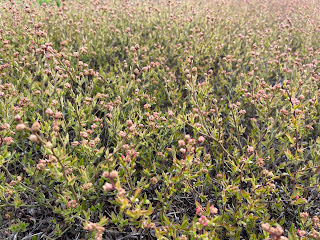This is our 5th Monilinia update for this
year.
There are a few things I like to mention in this
update:
1. Sprout-year
fields: I visited some sprout fields this week in the Colchester area, and all
of the fields I visited have plants emerging and this would be common to see in
other areas as well. In sprout fields, most of the common weeds are not hard to
see at this stage, including red sorrel, poverty oat grass, hair fescue and
other early development weeds. Before blueberry plants actively emerge, the next
1-2 weeks would be a good window for your spring herbicide application. Our
pest management guide has the herbicide information, please have a look: https://www.perennia.ca/wp-content/uploads/2018/03/Wild-Blueberry-WEED-INSECT-DISEASE-GUIDE-2021-WEB.pdf
2. Fruit-year
fields:
a. Most
of the areas are at the 40-50% F2 stage now in NS and some late developing fields,
such as the Advocate area and Cape Breton are at 32-35% F2. Growers in those
areas should be looking closely at their fields and getting ready for spraying
once at the 40-50% F2 threshold (Figure 1. and Table 1.).
b. Plant
development and monilinia infection symptoms: at this time, blueberry
fields in NS are looking at the percentage of F2 stage randing from 40%-70% or
higher and most of them would be at F4 and F5 now. However, I don’t see much
bloom yet in the fields I visited. It is starting though, and the bloom is ranging
from 0-5% this week. It is too early to see any symptoms. After the infection
period, if plants are infected by monilinia, it would start to show symptoms
7-10 days after. At this stage, I don’t have data or reports from the region
yet.
c. Botrytis:
I have growers asking about Botrytis already which is good to consider ahead of
time. Botrytis spores are produced begging at early bloom, so I would expect
once we reach the bloom period, then the infection risk is high and control
measures should be conducted. In NS, areas near the coast and fields that have
regular fog and wet periods will have a high risk for Botrytis. I will start
giving updates on Botrytis once we are at the infection period.
d. Field
activities to consider for fruit fields: Monilinia control is
still a top priority this time of the year and growers should be looking at
Botrytis controls (registered products and field monitoring) and also getting
ready for pollination once we are in the bloom window. Since the pollination
time is also the time that a lot of growers will be using fungicides, so please
make sure you are spraying with caution and minimize the risks for bees while
applying fungicides.
Table 1. Monilinia Update
for Nova Scotia- May 14, 2021
|
Wild blueberry production
regions, NS |
The average percentage
of floral buds at F2 or beyond |
|
|
|
|
Cape Breton |
35% |
|
|
|
|
Cumberland
County |
|
|
Advocate |
32% |
|
East side of
Farmington |
51% |
|
Pigen Hill |
52% |
|
Port Greville |
44% |
|
Webb Mt. |
38% |
|
Lynn Mt. |
50% |
|
Springhill |
Greater
than 40% |
|
Oxford |
Greater
than 40% |
|
Amherst |
Greater
than 40% |
|
Parrsboro |
Greater
than 40% |
|
Southampton |
Greater
than 40% |
|
Newville |
Greater
than 40% |
|
Collingwood and
Windham Hill |
Greater
than 40% |
|
Athol |
Greater
than 40% |
|
Half way River |
Greater
than 40% |
|
|
|
|
South West Nova
Scotia |
Greater
than 40% |
|
|
|
|
Hants County |
Greater
than 40% |
|
|
|
|
Halifax County |
Greater
than 40% |
|
|
|
|
Guysborough
County |
Greater
than 40% |
|
|
|
|
Colchester
County |
Greater
than 40% |
|
|
|
|
Pictou and
Antigonish County |
Greater
than 40% |
The next update is on May 21st.







